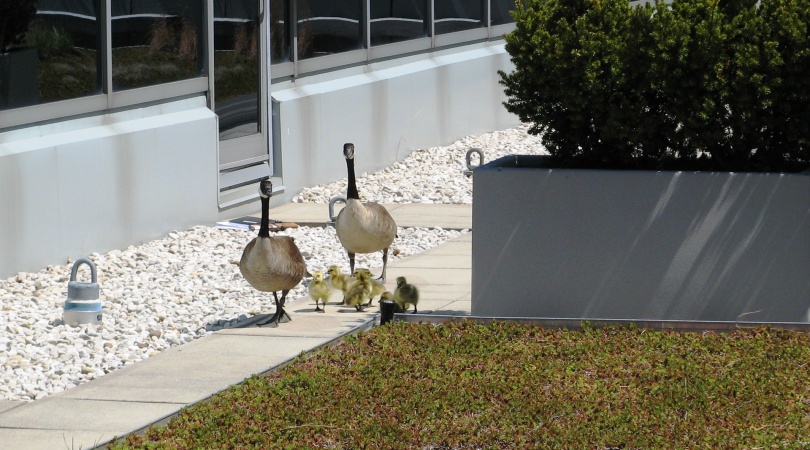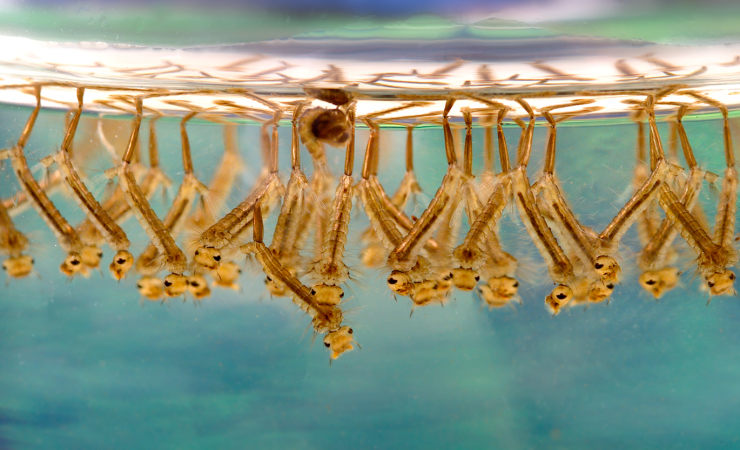Wildlife
Geese[edit]
Canada Geese and Cackling Geese can cause damage by eating vegetation, and mess by leaving droppings. In some urban settings they can pose a further nuisance by alarming members of the public.
They are often associated with stormwater management ponds. As many forms of LID reduce or eliminate standing water, the habitat for geese is reduced.
However, geese have even been found nesting on extensive green roofs in our region.
Here are some tips on control:
- <textsuccess>Discourage the feeding of any wildlife:</textsuccess> This may require public education with signage.
- <textsuccess>Discourage geese from taking off and landing:</textsuccess> Geese require open space which can be broken up with fencing or vegetation barriers such as hedges
- <textsuccess>Mow less frequently:</textsuccess>Geese prefer to eat the shorter, younger shoots of turf grass. Reducing mowing saves maintenance budget, and on vegetation filter strips and in enhanced grass swales the roughness (Manning's 'n') is increased. Increased roughness slows flow, allowing more water to infiltrate into the soil.
- <textsuccess>Bird deterrent tape:</textsuccess>Geese are slightly discouraged by shiny/flickering/reflective movement. Foil tape or flags are available for this purpose. This can be a useful strategy on recently seeded areas or on green roofs, in the late winter, at the start of nesting season.
Mosquitoes[edit]
Mosquitoes are a vector for many global diseases. In Ontario they are associated with transmission of West Nile Virus[1]. Low impact development technologies reduce the amount of standing water compared to traditional stormwater ponds. However there are a few additional design recommendations that can reduce mosquito habitat even further:
- <textsuccess>Mesh is the first line of defense:</textsuccess> A mesh size of 1.5 mm or smaller is recommended where a screen is used to exclude mosquitoes from a tank or other standing water[2],
- The Ministry of the Envionment and Climate Change permit just two larvicides to be used to kill mosquito larvae growing in the water[3]:
- <textsuccess>Bacillus thuringiensis israeliensis (Bti):</textsuccess>Note that provincial regulations permit only granular application, rather than 'dunks' or 'pucks' available elsewhere. This means frequent application may be necessary,
- <textsuccess>Methoprene:</textsuccess>This product can only be used by licensed individuals as it is slightly toxic to some fish species.
Airborne adulticides for mosquito control are permitted for use in Ontario. But their use is not recommended for most forms of stormwater control.
Encouraging populations of bats, birds, dragonflies and other natural predators is worthwhile for improving biodiversity.
But has not been demonstrated as an effective means of mosquito control.
Mammals[edit]
Is digging by squirrels/racoons etc. a problem?
I've witnessed green roofs being dug though by squirrels.
Humans[edit]
Vandalism exists. Recommend signage and engagement.
Community Engagement
Also write a bit about Landscape Architecture and deviance!
See Also[edit]
| SEND US YOUR FEEDBACK ABOUT THIS PAGE |

